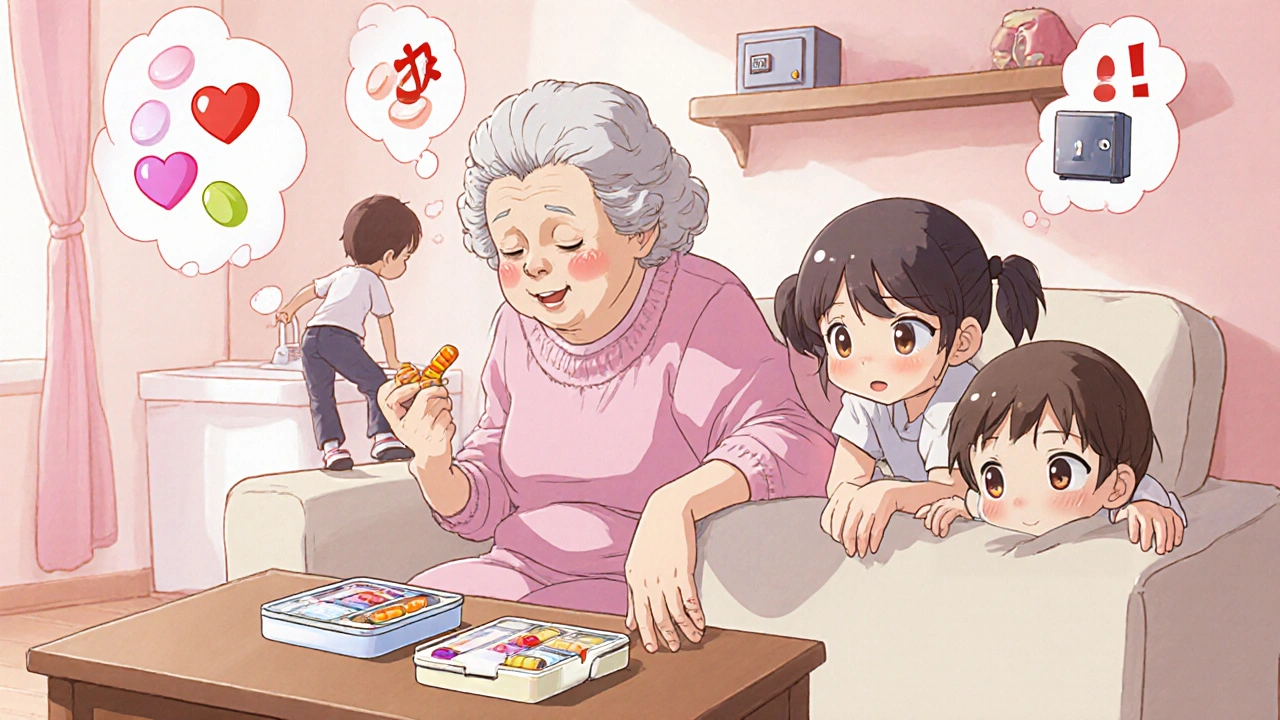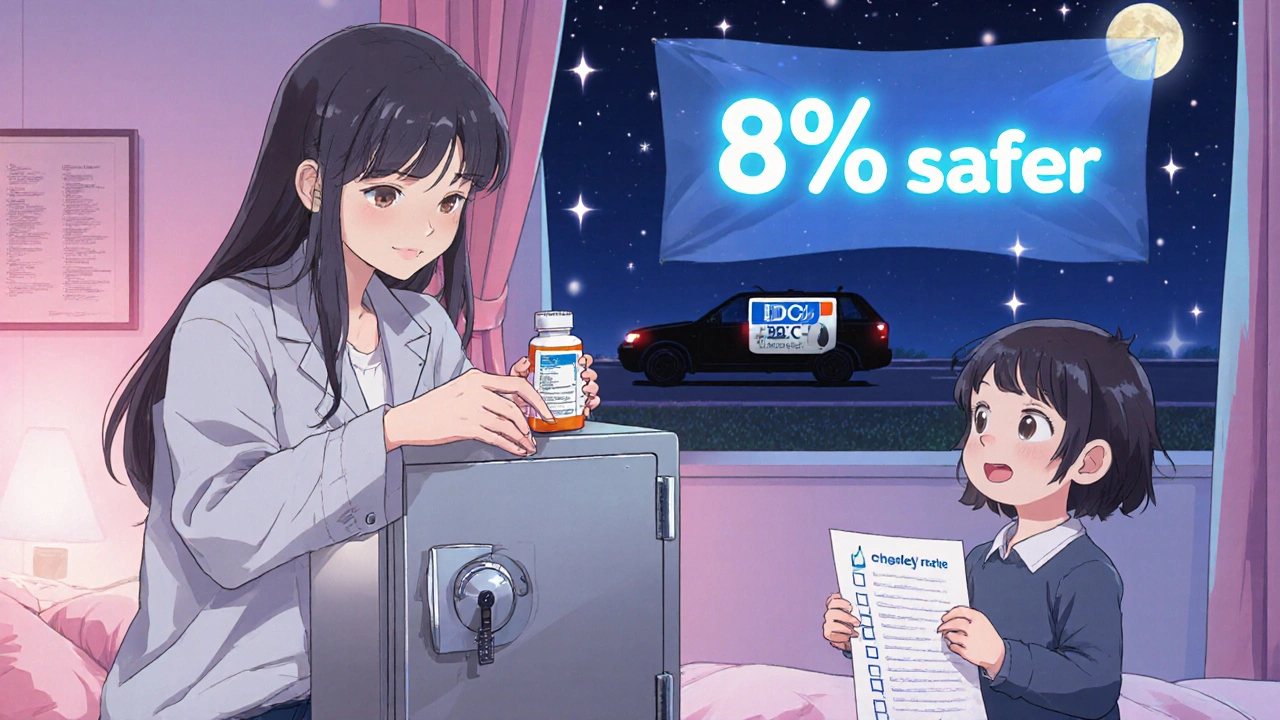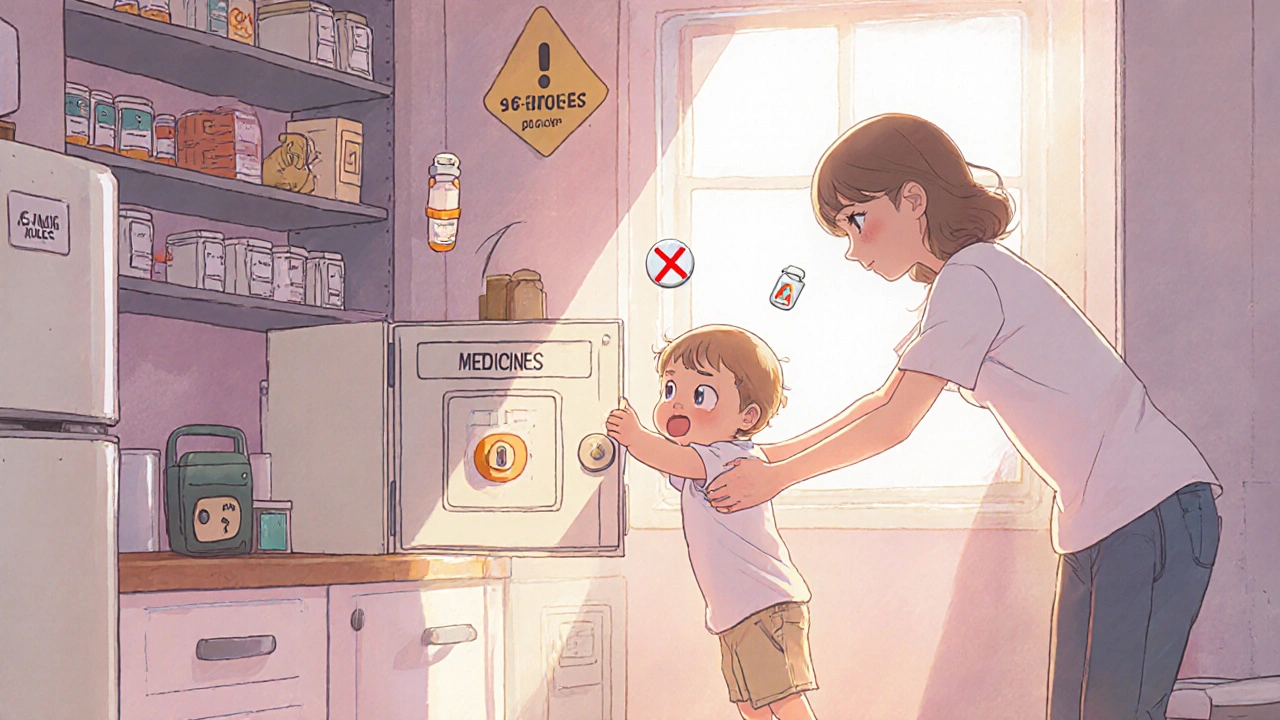Every year, around 60,000 children under five end up in emergency rooms because they got into medicine they weren’t supposed to. That’s not a rare accident-it’s a preventable crisis. And it’s happening in homes where parents think they’re being careful. You leave the pill bottle on the counter for two minutes while you answer the door? Your toddler just learned how to open cabinet latches. You store meds in the bathroom because it’s convenient? That’s the first place kids learn to climb. This isn’t about being paranoid-it’s about understanding how quickly things can go wrong.
Why Child-Resistant Caps Aren’t Enough
You’ve bought the bottles with the twist-and-push caps. You feel safe. But here’s the truth: half of all children under five can open those caps in less than a minute. That’s not a myth. It’s from Express Scripts’ 2023 safety analysis, based on real tests with hundreds of kids. The U.S. Consumer Product Safety Commission requires these caps to resist 200 children aged 42-51 months for 10 minutes. But real life doesn’t work like lab tests. Kids don’t give up after 10 seconds. They watch. They copy. They try again.
And it’s not just about the caps. A 2022 study in the Journal of Pediatric Health Care tracked 1,200 households. Those who relied only on child-resistant packaging saw accidental ingestions at a rate of 28%. Those who locked their meds away? That number dropped to 2%. The difference isn’t subtle-it’s life or death.
Where to Store Medications: The 36-Inch Rule
High shelves? Out of sight? That’s not enough. Children as young as 24 months can open standard cabinet doors. They’ve watched you do it a thousand times. The American Academy of Family Physicians says safe storage means putting meds at least 36 inches high-counter height or above-and locked away. Not just in a drawer. Not just on a shelf. Locked.
And don’t assume the bathroom is safe. It’s the most common place parents keep meds. But it’s also the most dangerous. Kids climb. They reach. They pull things down. The same goes for nightstands, purses, and coat pockets. A 2023 Safe Kids Worldwide survey found that 41% of parents still store meds in the bathroom-even though 89% know kids can get to them. Convenience beats caution. And that’s how accidents happen.
Locked Cabinets vs. Medication Safes: What Actually Works
Not all locks are created equal. A locked cabinet gives you 98% effectiveness at keeping kids out. A simple high shelf? Only 72%. That’s a huge gap. But if you want maximum protection, a dedicated medication safe is the gold standard.
Look for safes made of steel or hardened plastic, at least 6 inches x 4 inches x 2 inches. They should have tamper-evident features and a reliable lock-key, combination, or biometric. Brands like Med-Tek have 4.3 out of 5 stars on Amazon, with users reporting 92% effectiveness. The average cost? $45 to $120. That’s less than a month’s worth of groceries. Is your child’s safety worth that?
But here’s the catch: biometric locks take 5-8 seconds to open. For emergency meds like an EpiPen or asthma inhaler, that delay matters. That’s why Seattle Children’s Hospital recommends a triage system: keep emergency meds in a fast-access locked box you can open in under 3 seconds, daily meds in a higher, slower lockbox, and occasional meds in a travel-safe when you’re away.

The Two-Minute Rule: Never Leave Meds Unattended
Most poisonings don’t happen because a child found a hidden stash. They happen because a parent left a pill on the counter while answering the phone. Or while getting a glass of water. Or while putting a child in the car seat.
The CDC’s Up and Away campaign has a simple rule: never leave medication unattended for more than two minutes. Research shows kids can access a cabinet in 90 seconds. That’s less than the time it takes to brush your teeth. If you’re giving medicine, do it in a locked room. Put the bottle back immediately. No exceptions.
And don’t think you’re safe just because you’re “only a few feet away.” A 2024 Reddit thread with over 1,200 parent stories found that 87% had at least one near-miss. Most happened when they thought they were watching their child closely. That’s the illusion of safety.
Grandparents, Travel, and the Hidden Risks
One of the biggest dangers isn’t your home-it’s someone else’s. A 2024 Express Scripts survey found that 76% of grandparents don’t lock up meds when grandchildren visit. Why? “My grandchild knows not to touch medicine.” That’s the most dangerous lie in parenting. Kids don’t understand medicine. They understand candy. Chewable vitamins, aspirin, Tums-they all look like candy. In fact, a 2022 study showed a 17% spike in ingestions of chewable meds that look like sweets.
Travel is another blind spot. During holidays, pediatric poisonings jump by 31%. That’s why the CDC now offers portable “Travel Safety Kits”-small lockboxes that fit in hotel safes. If you’re staying somewhere, bring your own lockbox. Don’t rely on the hotel’s drawer. Don’t leave meds in your suitcase. Lock them. Every time.
What About Teenagers?
It’s not just toddlers. Teens are the second highest group for accidental and intentional medication misuse. The National Association of Pediatric Nurse Practitioners recommends a monitored system for households with teens: each dose is logged and verified by an adult. This simple step reduces prescription misuse by 67% over time.
Don’t assume your teen is responsible. A study of 12,000 families showed that even kids who’ve never misused meds before can start when they’re bored, stressed, or curious. Keep all meds locked-even if they’re your own. And talk to your teen about why this matters.

Disposing of Old Meds: Don’t Flush or Toss
Expired meds in your cabinet? That’s a hazard. The CDC says the safest way to dispose of them is to mix them with something unpleasant-like coffee grounds or kitty litter-seal them in a container, and throw them in the trash. Don’t flush them. Don’t just toss the bottle.
And here’s good news: 78% of U.S. communities now have permanent drug disposal kiosks at pharmacies. Check with your local pharmacy. If they have one, use it. It’s free, safe, and prevents meds from ending up in water supplies or in the hands of someone who shouldn’t have them.
Training Your Whole Household
This isn’t just your job. Everyone who comes into your home needs to know the rules. Babysitters. Grandparents. Aunts. Cousins. Even older siblings.
Practice a quick safety drill once a month. Show them where the meds are stored. Show them how the lock works. Remind them: if you’re not locking it, you’re risking a child’s life. Families who do this regularly reduce accidental access by 83% compared to those who just rely on child-resistant packaging.
The Bigger Picture: Why This Matters
Every accidental ingestion costs about $3,217 in medical bills. Annually, pediatric medication poisonings cost the U.S. over $67 billion. That’s not just money-it’s time lost from work, stress on families, and trauma for kids.
But the real cost? The ones we don’t count. The child who nearly dies. The parent who never sleeps the same way again. The family that learns the hard way that “I thought I was being careful” doesn’t undo what happened.
Storing meds safely isn’t about being perfect. It’s about being consistent. It’s about choosing lock over convenience, planning over hope, and protection over assumption. You don’t need to buy a fancy safe. You don’t need to be a safety expert. You just need to lock it up. Every time. No exceptions.
Can I store medications in the bathroom?
No. Bathrooms are the most dangerous place to store meds. Kids climb, reach, and open cabinets easily. Humidity also damages some medications. Store them in a high, locked cabinet in a bedroom or kitchen instead.
Are child-resistant caps reliable?
No. Half of children under five can open them in under a minute. They’re designed to slow down adults, not keep kids out. Always pair them with a locked storage container.
What should I do if my child swallows medicine?
Call Poison Control immediately at 1-800-222-1222. Don’t wait for symptoms. Don’t try to make them vomit. Keep the medicine bottle handy-providers need to know what was taken, how much, and when.
How do I store insulin safely?
Insulin must be refrigerated at 36°-46°F. Store it in a locked container inside the fridge, not on the door. Use a separate, labeled bin so it’s easy to find and hard for kids to access. Never leave it unrefrigerated for more than 28 days.
Is it okay to keep medicine in a pill organizer?
Only if it’s locked. Weekly pill organizers left on counters are a major cause of accidental ingestions. They look like candy, are easy to open, and often contain multiple types of meds. Always store them in a locked box, even if they’re for daily use.
Do I need to lock up over-the-counter meds too?
Yes. Tylenol, ibuprofen, allergy pills, and even cough syrup can be dangerous in large doses. Most pediatric poisonings involve OTC meds. Treat them the same as prescription drugs: locked, high, and out of sight.
What’s the best way to store meds while traveling?
Use a portable lockbox designed for travel. Keep it in your carry-on or a locked suitcase compartment. Never leave meds in a hotel drawer, purse, or car. The CDC recommends these kits because 31% more poisonings happen during holidays.
How do I teach my kids about medicine safety?
Don’t tell them medicine is candy. Say, “This is only for grown-ups. It can make you very sick if you take it.” Keep explanations simple and consistent. Use books or videos made for kids about medicine safety. Reinforce the rule: never touch medicine without an adult.


Aidan McCord-Amasis
November 15, 2025 AT 11:44Just lock it. 🤦♂️
Katie Baker
November 16, 2025 AT 13:07I used to think I was safe ‘cause I kept meds on the top shelf… until my 2-year-old opened the bathroom cabinet like a pro. Now everything’s in a locked box under the sink. Best decision ever. 😅
ASHISH TURAN
November 18, 2025 AT 12:45My mom used to say, ‘Kids are curious, not evil.’ And she’s right. But curiosity doesn’t care if you meant well. Locking meds isn’t paranoia-it’s just parenting with eyes open. I keep mine in a locked drawer in my bedroom now. No exceptions.
Ryan Airey
November 18, 2025 AT 16:24Let me guess-you also think ‘child-resistant’ caps are a real solution? Please. That’s like saying ‘seatbelts prevent all car crashes.’ No. They slow down idiots. The real fix? Lock it. Period. If you’re still storing meds in the bathroom, you’re not a parent-you’re a liability waiting to happen.
Hollis Hollywood
November 18, 2025 AT 19:52I read this whole thing with my heart in my throat. I used to keep my husband’s blood pressure pills on the nightstand because I forgot to put them away. One day, my daughter grabbed one and swallowed it before I could react. We made it to the ER in time, but I haven’t slept the same since. Now everything’s in a locked cabinet, even my vitamins. I don’t care how inconvenient it is. I’d rather open a lock 50 times a day than live with what could’ve happened. I’m not trying to scare anyone-I’m just saying, please don’t wait for your nightmare to happen before you act.
Edward Ward
November 20, 2025 AT 00:18It’s fascinating how society conflates convenience with safety-especially when children are involved. We’ve built entire systems around the illusion of control: child-resistant caps, ‘out of reach’ shelves, ‘I’m just going to be a second.’ But children don’t operate on human logic. They operate on repetition, observation, and instinct. The real tragedy isn’t the 60,000 ER visits-it’s that we keep pretending this is a matter of ‘being careful’ rather than designing environments that remove the possibility of error entirely. Locking meds isn’t an extra step-it’s the baseline. Anything less is negligence dressed up as trust.
Jessica Chambers
November 21, 2025 AT 00:35Oh wow, so now I’m a bad mom because I keep my EpiPen on the counter? 😏 I guess I should’ve read the 12-page manual before giving my kid peanut butter… 🙄
John Foster
November 21, 2025 AT 18:53There’s a deeper truth here, buried under all the safety tips and statistics. We live in a world that rewards speed, efficiency, and multitasking-and we’ve trained our children to be little operators of that same system. We leave pills out because we’re ‘just grabbing a glass of water.’ We don’t lock things because ‘it’s only for a minute.’ But children don’t live in minutes. They live in moments-and in those moments, they become explorers, scientists, investigators of the unknown. The real danger isn’t the pill bottle. It’s our refusal to see them as full agents of their own curiosity. We want them to be safe, but we don’t want to change how we live. That’s the real crisis.
Adam Dille
November 22, 2025 AT 01:28Just bought one of those little Med-Tek safes after reading this. $60 well spent. My toddler tried to open it yesterday-banged on it for 10 minutes, then gave up and went back to Legos. I’m not gonna lie, it felt good to hear that plastic clunk shut. 😌
Chris Bryan
November 23, 2025 AT 20:35They’re coming for your meds. Next they’ll ban sugar. Then TV. Then laughter. Lock your pills, lock your kids, lock your life. Welcome to the new normal. 🇺🇸
Ogonna Igbo
November 25, 2025 AT 18:01In Nigeria, we don’t lock medicine. We teach kids respect. If your child touches medicine without permission, you teach them discipline. Not fear. Not locks. Discipline. Your Western obsession with safety is weakening your children. They need to learn boundaries, not be locked away from the world.
Shyamal Spadoni
November 27, 2025 AT 04:52Wait… so you’re telling me the gov’t and Big Pharma are using this ‘child poisoning’ thing to push us to buy expensive safes so they can track our meds? And the CDC? They’re just fronting for the surveillance state. I’ve got a cousin who works at a pharmacy-he says 90% of ‘accidental ingestions’ are staged to sell more locks. I’m not buying it. I keep my pills in a mason jar on the windowsill. Let ‘em try.
Andrew Eppich
November 28, 2025 AT 17:21It is a matter of basic responsibility. The failure to secure pharmaceuticals in a manner that precludes access by minors constitutes a dereliction of parental duty. The data is incontrovertible. The solutions are simple. To ignore them is not negligence-it is moral failure.
BABA SABKA
November 30, 2025 AT 08:48Bro, the real issue here is the systemic failure of American parenting. You lock your meds because you don’t trust your own kids? In my culture, we teach kids to respect authority and boundaries. No locks needed. Just discipline. And if a kid gets into medicine? That’s a teachable moment. Not a crisis. You turn everything into a security threat. It’s exhausting.
Jonathan Dobey
December 1, 2025 AT 02:48Thanks for sharing this. I’m the author. I’ve been working on this piece for months. I didn’t realize how many of you have lived through near-misses. I’m not here to shame anyone-I just want us to stop pretending we’re safe. Lock it. Every time. Even if you think you’re being careful. You’re not. And I’m grateful you’re all here, talking about it. Let’s keep this going.